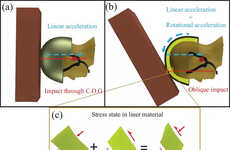
MIT's New Structural Graphene Compound is Stronger Than Steel
References: news.mit.edu & engadget
The Massachusetts Institute of Technology has recently designed a new graphene compound that has a density of just five percent yet is ten times stronger than steel. The structural compound is the first to be able to make practical use of the strength of graphene, which is itself the strongest material known to science.
Graphene's potential as a super-strong material is not a newly discovered one. Researchers have known about graphene for a long time, but its natural form has stymied them in the past. Graphene is a two-dimensional form of carbon, with the thickness of a single atom. While incredibly strong in this two-dimensional structure, it is far too small to be practically useful.
The MIT researchers were able to create their 3D graphene compound by inventing a new geometrical configuration that folds the 2D material into a 3D shape.
Graphene's potential as a super-strong material is not a newly discovered one. Researchers have known about graphene for a long time, but its natural form has stymied them in the past. Graphene is a two-dimensional form of carbon, with the thickness of a single atom. While incredibly strong in this two-dimensional structure, it is far too small to be practically useful.
The MIT researchers were able to create their 3D graphene compound by inventing a new geometrical configuration that folds the 2D material into a 3D shape.
Trend Themes
1. Graphene Innovation - The development of a new graphene compound with practical use opens the door for disruptive innovations in various industries.
2. Lightweight Structural Materials - The creation of an ultra-strong yet lightweight graphene compound presents opportunities for disruptive innovations in the field of structural materials.
3. Advanced Material Engineering - The invention of a new geometrical configuration for graphene compound production provides prospects for disruptive innovations in the field of advanced material engineering.
Industry Implications
1. Aerospace - The aerospace industry can leverage the ultra-strong lightweight graphene compound to develop lighter and more fuel-efficient aircraft.
2. Automotive - The automotive industry can benefit from the graphene compound's strength and lightweight properties to create stronger and safer vehicles.
3. Construction - The construction industry can explore the use of the graphene compound for stronger and more resilient structural materials, leading to innovative building designs.
5.9
Score
Popularity
Activity
Freshness























